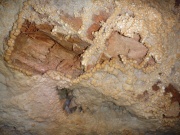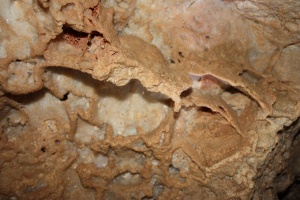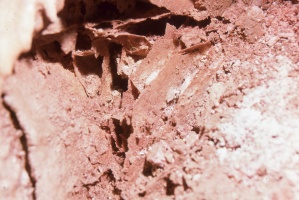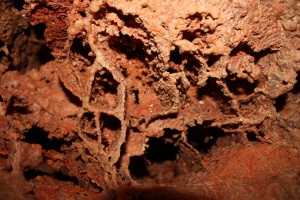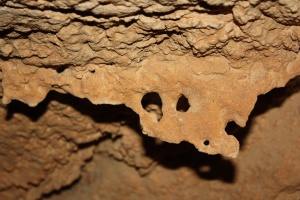Calcite (Inventory)/Boxwork
From LagWiki
(Move the gallery) |
|||
| (11 intermediate revisions not shown) | |||
| Line 1: | Line 1: | ||
| - | + | {{Inventory image|File:Boxwork.JPG|Boxwork. Other formations visible include [[Calcite (Inventory)/Popcorn|popcorn]] and [[Calcite (Inventory)/Spar/dogtooth|dogtooth spar]].}} | |
| + | The '''Boxwork''' [[Calcite (Inventory)|Calcite]] inventory field should be used to list stations which exhibit boxwork. | ||
| - | + | Boxwork is not technically a speleothem but a speleogen. That is, it is not a formation but a residual of dissolution. Boxwork forms when cracks in the bedrock are filled with a mineral which is harder to dissolve than the bedrock itself. When the bedrock dissolves, it leaves the mineral which used to fill the cracks exposed. It often appears on the ceiling but may be present anywhere bedrock is exposed. It may be obscured by secondary formations. Boxwork can appear as small examples or large areas. It often takes on polygonal shapes (usually rectangular) but may be almost any shape. It need not project far from the rock to be considered boxwork. Often it is a different color than the bedrock (usually darker). Alternative explanations for boxwork exist which involve cracks in the bedrock being filled with minerals after the cave formed. | |
| - | Although the field appears in the calcite section of the ''CCNP Cave Inventory Form'', any boxwork no matter its specific mineral content (which may be difficult to identify anyway and | + | Although the field appears in the calcite section of the ''CCNP Cave Inventory Form'', any boxwork no matter its specific mineral content (which may be difficult to identify anyway and may not be calcite) should be listed. |
| - | [[ | + | ==References== |
| + | *Palmer, Arthur N. (2007) ''Cave Geology'' CAVE BOOKS, Dayton, OH pp 343-344 ISBN-13: [[Special:Booksources/978-0-939748-66-2|978-0-939748-66-2]], ISBN-10: [[Special:Booksources/0-939748-66-5|0-939748-66-5]] | ||
| + | *Hill, Carol; Paolo Forti (1997) ''Cave Minerals of the World (Second Edition ed.)'' National Speleological Society pp 52-54 ISBN: [[Special:Booksources/1-879961-07-5|1-879961-07-5]] | ||
| + | |||
| + | ==Boxwork, Calcite== | ||
| + | <gallery perrow=2 widths=300px heights=200px> | ||
| + | File:Boxwork.jpg|Boxwork | ||
| + | File:1 Boxwork.jpg|Boxwork | ||
| + | File:Boxwork 3.JPG|Boxwork with a [[Calcite (Inventory)/Calcite Coating|calcite coating]] | ||
| + | File:Boxwork fin.JPG|A singular boxwork fin protruding from the wall | ||
| + | </gallery> | ||
| + | |||
| + | {{Cave inventory}} | ||
Current revision as of 22:10, 9 August 2013
The Boxwork Calcite inventory field should be used to list stations which exhibit boxwork.
Boxwork is not technically a speleothem but a speleogen. That is, it is not a formation but a residual of dissolution. Boxwork forms when cracks in the bedrock are filled with a mineral which is harder to dissolve than the bedrock itself. When the bedrock dissolves, it leaves the mineral which used to fill the cracks exposed. It often appears on the ceiling but may be present anywhere bedrock is exposed. It may be obscured by secondary formations. Boxwork can appear as small examples or large areas. It often takes on polygonal shapes (usually rectangular) but may be almost any shape. It need not project far from the rock to be considered boxwork. Often it is a different color than the bedrock (usually darker). Alternative explanations for boxwork exist which involve cracks in the bedrock being filled with minerals after the cave formed.
Although the field appears in the calcite section of the CCNP Cave Inventory Form, any boxwork no matter its specific mineral content (which may be difficult to identify anyway and may not be calcite) should be listed.
References
- Palmer, Arthur N. (2007) Cave Geology CAVE BOOKS, Dayton, OH pp 343-344 ISBN-13: 978-0-939748-66-2, ISBN-10: 0-939748-66-5
- Hill, Carol; Paolo Forti (1997) Cave Minerals of the World (Second Edition ed.) National Speleological Society pp 52-54 ISBN: 1-879961-07-5
Boxwork, Calcite
Boxwork with a calcite coating |
